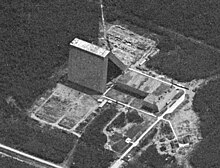Dunay radar

Dunay-3 (NATO: Dog House) radar receiver taken by US KH-7 spy satellite in 1967
|
|
| Country of origin | Soviet Union |
|---|---|
| Introduced | 1959 (Dunay-2) 1968 (Dunay-3) 1978 (Dunay-3M, Dunay-3U) |
| No. built | 3 |
| Type | early warning radar |
| Frequency | UHF |
| Range | 1,200 km (Dunay-2) 2,500 km (Dunay-3M) |
| Power | 100kW (Dunay-2) 3MW per sector (Dunay-3M) |
| Other Names | NATO: Dog House, Cat House, Top Roost, Hen Roost |
Dunay radar (Russian: Дунай, tr. Dunay literally Danube; NATO: Cat House, Dog House) was a system of two Soviet radars used to detect American ballistic missiles fired at Moscow. They were part of the A-35 anti-ballistic missile system. One sector of one of the radars, the Dunay-3U ("Cat House") is still operational and is run by the Russian Aerospace Defence Forces as part of the Main Control Centre of Outer Space.
The Dunay-2 was a prototype built in Sary Shagan as part of the experimental missile defence system "A". It consisted of separate transmitter and receiver complexes separated by 1 km. The power of the radar was 100 kW and its range was 1,200 km. The NATO codename was "Hen Roost".
The Dunay-3 (Russian: Дунай-3М, tr. Dunay-3M; NATO: Dog House) was an upgrade of the Dunay-2 located in Kubinka, Moscow and became operational in 1968. Following an extensive upgrade in 1978 it was renamed Dunay-3M as part of the upgraded A-35M ABM system. It consisted of separate receiver and transmitter buildings separated by 2.5 kilometres (1.6 mi).
The transmitter covered two sectors (roughly north and south) and its array was 200 metres (660 ft) long and 30 metres (98 ft) high. The power of each sector was about 3MW. The receiver was a building 100m x 100m containing 2 passive electronically scanned array radars as well as the command and control centre for the A-35 system. The range of the system was 2,500 kilometres (1,600 mi).
...
Wikipedia
